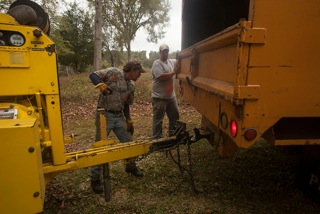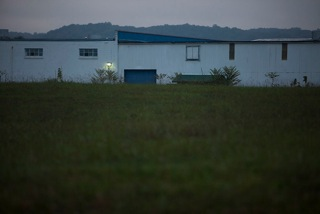Losing Sparta
Losing Sparta
Thousands of manufacturing plants close each year in the United States. What happens after?
By Esther Kaplan
Last August, more than a year after the Philips lighting fixture plant in Sparta, Tennessee, closed its doors, Bo McCurry and Ricky Lack stepped out of Lack’s beat-up Ford Ranger and walked up the sloping, tree-lined drive to the plant’s padlocked gates. It was the first time either one had been back since the closure. Red mallow blossomed under a sign that still read PHILIPS PROFESSIONAL LUMINAIRES—SPARTA OPERATIONS. Beyond the gates, a monarch butterfly floated by, and a red fox darted out into what was once a bustling loading area, now silent except for the sounds of birds.
“You see that little old blue door?” Lack asked. “Next to the steps. See the bright yellow steps over against the four roll-up doors? Inside. The shipping department. They said we’re shutting the building, closing the plant. End of story.
“They slipped right out that back door and got in their car and drove away, and that’s it. Couldn’t believe it.”
“Couldn’t believe it,” McCurry said. “Everybody was crying.”
It was front page news in the Sparta Expositor when the plant opened its doors in 1963, and the plant had kept hundreds of people employed in rural White County in the decades since. The layoffs started in May 2011 and came in waves until, on March 31, 2012, the last of the plant’s 284 workers finished sweeping up the factory floor and walked out. After so much time, everyone I asked about that day still choked up and struggled, at least for a moment, to speak. Scott Vincent, hired on to assist with an environmental inspection of the vacant plant, was the very last to go. “To think about all the people that you’d spent your life with. You’d lived with ’em and watched ’em die, and watched their families die and be sick, and suddenly they were all just gone! I mean it was really a struggle to have to live with all that.”
The night before, I’d met up with Brent Hall, the plant’s IBEW union rep, along with McCurry, Lack, Vincent and a couple other long-timers, many of whom had rotated in and out of the shop’s union leadership over the years. I’d arrived in town just as their extended unemployment was running out and asked how everyone was getting by. Of the five of them, only two had found jobs. Only Vincent had found a decent manufacturing job, with full-time hours and health benefits. Lack, fifty-five, was working as a tree pruner, his skin now a deep mahogany from long hours spent in the sun. His hourly pay wasn’t as good as it was at the plant, and it wasn’t steady work, only three or four days a week, without paid time off or benefits. Lonnie Barlow had given up on finding work, and went into early retirement at age sixty-six, turning his attention to the few head of cattle he kept on his patch of land. Jim Gray, who’d lost an eye at the plant, was using state and federal grants for trade-affected workers to go back to school, studying, at fifty-eight, among a classroom of eighteen- and twenty-year-olds, how to program industrial equipment. He wasn’t particularly optimistic about his chances for getting a decent job afterward, but his unemployment benefits would continue during his schooling, so he figured it was something to keep him going while he looked for work. He speaks wistfully about an electrician job he’d been up for some months back at the Volkswagen plant in Chattanooga, an hour and a half away, that would have started at around $17 an hour—the same plant where a widely watched UAW unionization battle would later take place. He guessed that all of the other finalists were in their fifties or sixties, too, and all urgently looking for work. One had driven all the way from Detroit to take the practical test.
The others I spoke with in town were faring no better. As the unemployment checks dried up, I heard of people selling their boats, their ATVs, and even their houses. Marriages were falling apart. People had started drinking. Jerry Pryor, fifty-four, got manufacturing work, making car mirrors, but he has a miserable shift—2:30 to 10:30 a.m.—and was driving twenty-five miles each way, burning up gas, for less than he got at Philips. Donna McCurry, forty-six, tried her hand as a CNA at a local nursing home, earning just a dollar above minimum wage, and then left that job to take over a small car repair shop. She and Bo had bought the shop with the life-insurance money she got after her son died in a car accident, along with some of their severance pay from the plant. But she was barely making ends meet.
She and Bo, fifty-eight, had recently split up. He was still out of work when we caught up, though now and again he found a temporary placement—he’d just done a few weeks at Unipres, a car parts plant 100 miles away in Portland, for less than $9 an hour, minus the $100 a week he paid into a carpool to get there and back. At one point a temp agency said it had a permanent placement for him at the S&S Screw factory in Sparta, but before his start date they called to cancel. He and everyone else I spoke with from the Philips plant are sure it’s because of the union. Bo was serving as president at the time of the plant closing, so he was interviewed on local television and in the Expositor, making him an easy target. Word was S&S hadn’t hired on a single union member from the plant, same as over at THK Rhythm, an auto parts plant, afraid they’d try to organize the place. Ten years earlier, someone they knew had tried to organize S&S, Bo said, “and they fired his ass on the spot.” (Neither firm returned calls for comment.) He can’t seem to figure out how to get a job. When he was younger, you got a job through a friend or relative or neighbor at a plant; now you have to apply through a computer, if you can find someone who has one, or drive 20 minutes to a temp agency in Cookeville. “I probably couldn’t get a job at Walmart as a door greeter,” he told me, defeated. Not only out of work but uninsured, he had to take out a $9,000 bank loan in May to pay for an operation on his herniated discs, what he calls “a deal with the devil,” leaving him to pay out $80 a month pretty much forever.
The stories I heard in Sparta give life to some of the most troubling data about the nature of the economic recovery. Decent paying jobs, like the ones at the Philips plant, where workers were pulling in as much as $16 an hour, have disappeared, replaced by jobs with poverty wages. A 2014 study from the National Employment Law Project found that mid-wage jobs comprised 37 percent of recession job losses, but only 26 percent of job growth during the recovery. The low wage jobs—Donna’s $8.25-an-hour nursing home job; Jerry’s $8.50-an-hour starting wage at his new factory job—were the opposite, constituting 22 percent of job losses and 44 percent of job growth. Some of the nation’s fastest-growing job sectors, such as home health care, have seen the sharpest drops in pay.
There will also be fewer actual jobs. The Bureau of Labor Statistics has projected a 23 percent growth in temp employment between 2010 and 2020, outpacing most other sectors. The American Staffing Association, which represents temp agencies across the country, sees this as one sign of a “fundamental shift in the role of staffing services in the economy,” with companies only wanting to “use talent” on an “on-demand basis.” I stopped by a couple of Cookeville’s many temp agencies. Most of them are located in strip malls, and nearly all are within yards of a storefront offering, by means of massive bright yellow billboards, car title or payday loans. Women at two agencies told me that the vast majority of their temp placements are now in manufacturing, and that in most cases these plants have outsourced their entire hiring process to agencies like theirs. Angela Atkins, of @Work, told me that after her cut, the factory hires are paid anywhere between $7.25 an hour—federal minimum wage—and $12 an hour. “Most of the time it’s temp to hire,” she said. “Other times it’s temp all the way, and they can keep ’em for years.” When laid-off workers come in having earned $15 an hour or more, she asks them, “What are your expectations?” Meaning, it’s time to lower them.
###
This is an excerpt from a longer essay that appears in the Summer 2014 issue of the Virginia Quarterly Review. It is reproduced here with permission.



